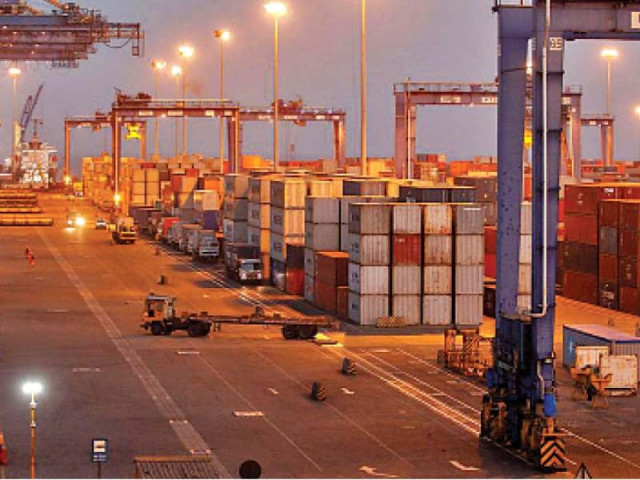Exporting out of Covid-induced economic crisis
Pakistan achieves higher export growth relative to competitors, but challenges remain

The dynamics involved in international trading activities are becoming as complex as ever as the world recovers from the Covid-19 pandemic-induced shock and reopens borders.
The Trade and Development Report 2021 of Unctad predicts that the global economy will grow 5.3% as it recovers from the adverse impact of Covid-19. This will be the fastest growth in the last five decades.
The report also suggests that the impact of the pandemic on the global South is greater than the impact it felt during the previous financial crisis. It is expected that the world economy will lose approximately $13 trillion between 2020 and 2022 relative to the pre-pandemic predictions of world output level.
More importantly, the impact of the pandemic on income levels as a percentage of GDP has been one of the highest in South Asia and Southeast Asia, with the economic impact likely to be 20% of gross domestic product (GDP).
Furthermore, the rise in commodity prices could severely dent recovery efforts in the South, which is already struggling economically due to the health crisis.
The WTO, in a recent press release in October 2021, highlighted the upward trend in global trade as economists upgrade their forecasts for 2021 and 2022.
The WTO predicts that the merchandise trade volume will increase by 10.8% in 2021, up from the prediction of 8% in March 2021.
However, the press release cautions against risks such as challenges to global supply chains as well as possibilities of large regional disparities as certain regions may report relatively slower recovery rates.
The WTO expects the services sector, in particular travel and leisure, to lag behind the trade of goods in terms of recovery rates. However, this is not to say that the impact of services sector on economic growth is any less important.
A recent publication of the World Bank titled “At Your Service? The Promise of Services-Led Development” focuses on the contribution of services sector to providing the crucial impetus towards economic transformation.
The publication reports that half of the workers in low and middle-income countries are employed in the services sector, while the workers have increasingly become more productive.
With the use of digital technologies and the scope of more high-skilled activities increasing within the services sector, there is a significant potential for increased international trading activities.
A more productive services sector can enable the manufacturing sector to improve its productivity level by complementing manufacturing activities and allowing a more efficient mix of inputs.
Pakistan’s exports, imports
Considering the data of exports and imports of Pakistan as reported by the Pakistan Bureau of Statistics (PBS), it revealed that exports and imports both recovered in FY21.
Exports increased by 18.3% and imports rose by 26.6% over the values reported for FY20.
Total exports of $25.3 billion are the highest ever reported in the country’s history, which suggests that export-oriented industries in Pakistan performed relatively better than several other developing countries, which struggled to trade during the pandemic.
As economic growth levels picked up in Pakistan, the demand for imports also increased. Total imports in FY21 were $56.4 billion, one of the highest levels reported in the country’s history.
Exports of services from Pakistan increased by 9.2% in FY21 over the value reported for FY20, primarily driven by the information and communication technology (ICT) sector.
The growth in exports from Pakistan was mainly due to the textile sector, which recorded an increase of 22.9% in exports in FY21 over the value reported for FY20. This has continued to increase in the first two months of FY22, with 28.7% growth.
The biggest contributors to the increase in exports were bed wear, knitwear and towels, which constitute value-added goods.
According to data extracted from ITC’s Trademap.org, approximately $9.8 billion of exports from Pakistan out of $13.1 billion worth of textile exports were destined to the US and Europe in 2020.
More specifically, $3.46 billion of exports were destined to the US and $1.37 billion of shipments were destined to the UK.
A majority of the products exported to the Western countries were made-up textile articles and apparel.
Although Pakistan has experienced higher export growth rates relative to regional competitors, challenges still remain that can impact long-term expectations of export-oriented sectors.
For instance, exports of apparels from Pakistan increased in 2020 while those of regional competitors such as India and Bangladesh decreased. Exports of apparels from India decreased by more than 20% in 2020 over the previous year.
As exports from regional competitors recover, competition is likely to intensify in major markets.
Another major hurdle in global trade is the logjam faced by supply chains as shipping costs reach unprecedented levels and congestions at major ports lead to significant slowdown and higher costs of trade.
With supply chain disruptions, preference may not only shift towards imports of necessary goods but the effectiveness of logistics and border facilitation become increasingly crucial as exporters demand timely shipment of their products.
In a nutshell, the recent gains in export levels must be considered with cautious optimism. As the world economy recovers from the pandemic-induced shock, the level of export competitiveness against regional counterparts will become increasingly important. It will be essential to boost productivity and capabilities of exporters.
The writer is the Assistant Professor of Economics & Research Fellow at CBER IBA
Published in The Express Tribune, October 25th, 2021.
Like Business on Facebook, follow @TribuneBiz on Twitter to stay informed and join in the conversation.



















COMMENTS
Comments are moderated and generally will be posted if they are on-topic and not abusive.
For more information, please see our Comments FAQ